AI Call Quality Monitoring: Predictive Analytics Tools
AI call quality monitoring has transformed how businesses handle customer interactions. By using machine learning and predictive analytics, companies can analyze calls in real-time, detect patterns, and anticipate issues before they escalate. This shift from reactive to proactive management improves customer satisfaction and reduces manual effort.
Key tools in this space include Level AI, Observe AI, CallMiner, Qualtrics, Loris, and Answering Agent. Each offers unique features like real-time analytics, sentiment analysis, predictive modeling, and integration capabilities, catering to businesses of all sizes.
Quick Comparison
| Tool | Key Features | Limitations | Best For | Cost Range |
|---|---|---|---|---|
| Level AI | Real-time sentiment analysis, predictive trends | High cost, complex setup | Large enterprises | $10,000+ monthly |
| Observe AI | Compliance alerts, churn prediction | Limited customization | Regulated industries | $5,000–15,000 monthly |
| CallMiner | Speech analytics, industry-specific models | Complex integrations | Mid to large businesses | $3,000–12,000 monthly |
| Qualtrics | Survey integration, real-time feedback | Limited call analytics | Customer experience teams | $2,000–8,000 monthly |
| Loris | User-friendly, quick setup | Limited scalability | Small to medium businesses | $500–3,000 monthly |
| Answering Agent | Affordable, unlimited calls | Fewer advanced features | Service businesses | $100–2,000 monthly |
Choosing the right tool depends on your business size, budget, and specific needs. Larger organizations may prioritize advanced features, while smaller businesses often seek cost-effective solutions with easy implementation.
How AI Makes Call Centers 100% More Efficient | Auto Quality Assurance
1. Level AI

Level AI is a powerful platform designed to improve call quality monitoring through advanced predictive analytics. It processes over a million manual QA interactions and a hundred million Auto-QA interactions annually, showcasing its ability to handle enterprise-level demands. Let’s dive into its standout features.
Real-time Analytics
Level AI uses natural language understanding (NLU) to analyze customer intent, monitoring 100% of conversations in real time - a significant leap from older systems that only cover 1-2%.
The platform’s Real-Time Manager Assist feature tracks live conversations with key performance metrics like call duration, Customer Sentiment Score, conversion probability, deal size, and Agent InstaScore. Managers can access a centralized dashboard to monitor live calls, click on specific KPIs for detailed insights, and step in using features like call whispering or barging when necessary.
Level AI also excels in customer sentiment analysis, tagging and tracking emotions - both positive and negative - in real time. For critical situations, such as potential customer churn, the system can send custom alerts to supervisors via Slack or Microsoft Teams, ensuring swift action.
Predictive Modeling
Level AI doesn’t just provide immediate insights - it also predicts future trends. By analyzing unstructured omnichannel data, its AI engine uncovers actionable insights. The platform identifies customer feedback, emerging trends, anomalies, and sentiment patterns from interactions.
In 2022, AI-powered contact center software achieved a 2X (+100%) improvement in accuracy compared to older keyword-matching systems. This is thanks to Level AI’s ability to go beyond basic keyword detection, understanding context and intent for deeper analysis.
Integration Capabilities
Level AI integrates effortlessly into existing workflows, offering real-time guidance for next-best actions and post-call dispositions. It also provides AI-driven coaching plans and evidence-based feedback to help agents continuously improve their performance.
The platform’s API ensures smooth integration with current business systems, with flexibility to adapt based on an organization’s specific technology stack and needs.
Scalability
Level AI’s architecture is built to scale, maintaining its accuracy even as call volumes increase. Its automatic speech recognition (ASR) technology is 7% more accurate than standard industry solutions, ensuring reliable transcription and analysis at any scale.
2. Observe AI
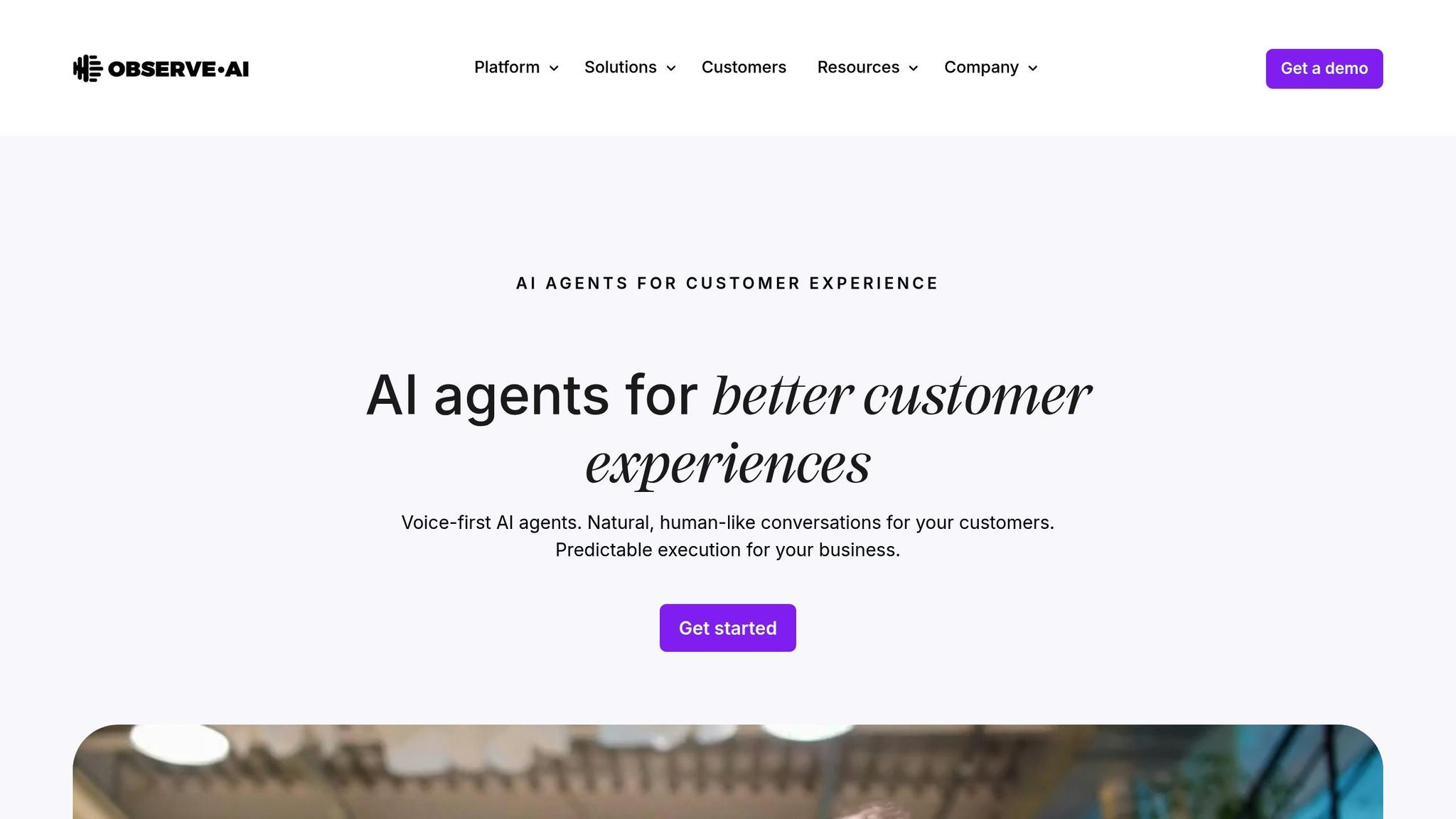
Building on Level AI's focus on real-time analytics and predictive modeling, Observe AI takes these concepts further with a well-rounded approach. It shines as a conversation intelligence platform designed to improve call quality monitoring. By blending advanced machine learning with actionable insights, it transforms customer interactions into valuable business data.
Real-time Analytics
Observe AI processes 100% of customer interactions across both voice and digital channels, identifying key moments like compliance issues, customer frustration, or sales opportunities - without relying on sampling methods. Supervisors are alerted in real time when specific triggers occur, enabling immediate action through tools like call coaching or escalation protocols.
Its sentiment analysis engine monitors emotional cues during conversations, offering real-time metrics like customer satisfaction scores and agent performance. After a call ends, the platform generates a summary within seconds, highlighting essential points, recommended actions, and predicted outcomes.
These real-time insights feed directly into predictive analytics, empowering businesses to make proactive decisions.
Predictive Modeling
Observe AI goes beyond standard analytics by forecasting future customer behavior and business outcomes. Using machine learning, it analyzes historical conversation data to predict customer churn risks, upselling opportunities, and the likelihood of service escalations.
For example, it can pinpoint customers at risk of leaving or identify those who might be open to additional purchases. These predictions allow businesses to address potential issues early and seize revenue opportunities before they slip away.
The platform also forecasts agent performance trends, helping managers spot team members who could benefit from extra training or support. This proactive approach ensures resources are allocated effectively, reducing the risk of performance-related dips in customer satisfaction.
Integration Capabilities
Observe AI connects effortlessly with existing business systems through pre-built connectors for popular CRM platforms, contact center software, and workforce management tools. Additionally, its API-based integrations allow businesses to embed conversation insights directly into their workflows.
The platform also enhances quality assurance processes by automatically scoring calls based on customized evaluation criteria. Flagged interactions are routed to the appropriate supervisors for review, streamlining the QA workflow.
Scalability
Thanks to its cloud-native design, Observe AI supports deployments of any size. It processes millions of conversations per month without compromising accuracy or speed.
The system automatically scales to handle fluctuations in call volume, ensuring peak periods don't slow down processing or reduce analytical depth. This flexibility makes it an excellent fit for businesses of all sizes, from small call centers to large enterprise operations.
With its multi-tenant architecture, the platform accommodates complex organizational setups. Different departments or business units can maintain separate analytical environments while sharing infrastructure to keep costs manageable. This scalability positions Observe AI as a powerful tool for businesses looking to optimize their customer interactions.
3. CallMiner
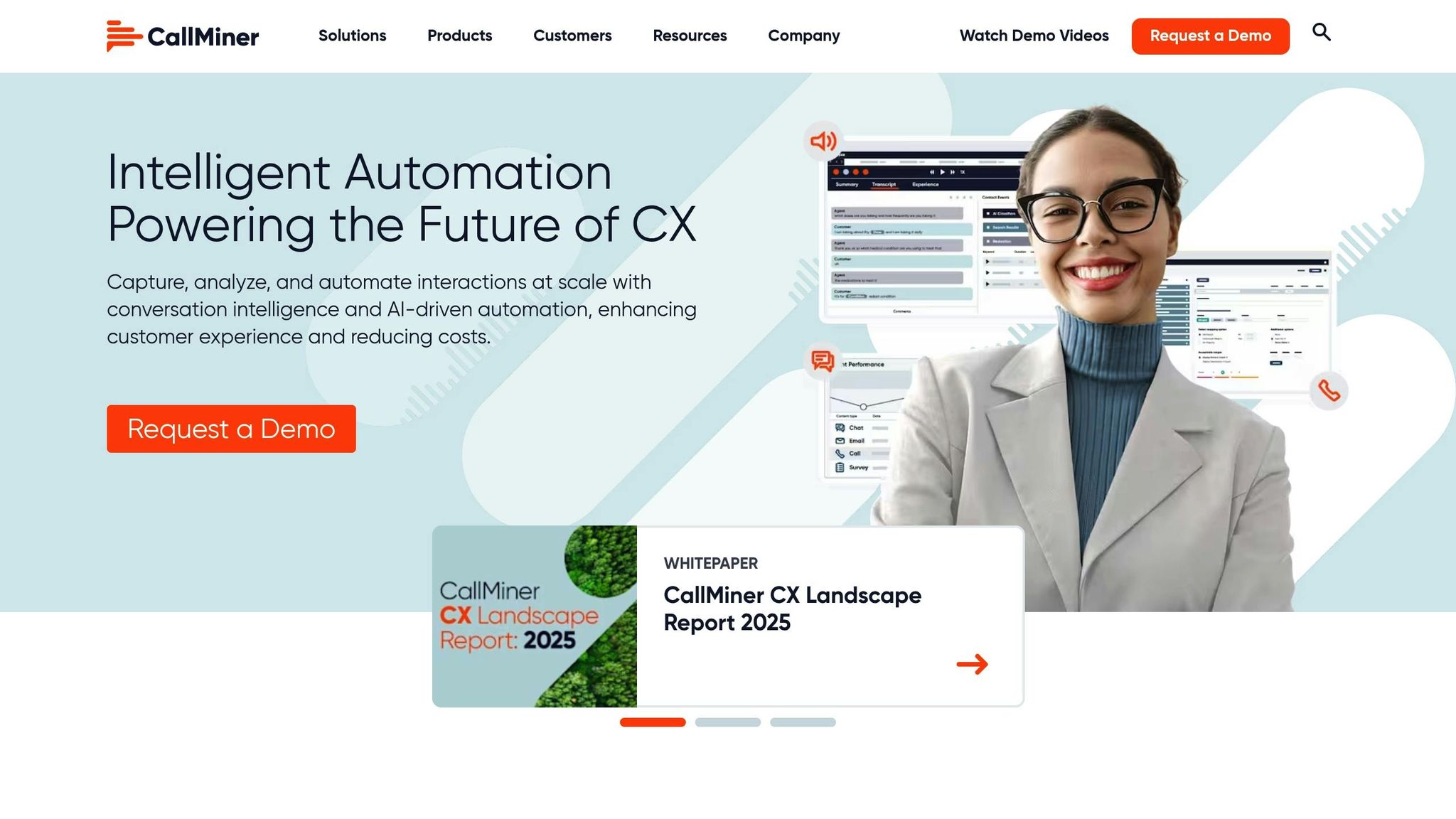
CallMiner stands out by enhancing connectivity through the integration of diverse data streams, creating a more complete view of the customer. It offers an open platform that securely connects data and applications using auto-redacted, scalable APIs, pre-built Connectors, and the Open Voice Transcription Standard (OVTS).
What makes CallMiner particularly efficient is its pre-built Connectors. These are designed to deliver fast, enterprise-level integration without the need for extra IT resources. Additionally, it enables two-way data exchange through both these Connectors and its developer API, making it highly adaptable for various business needs.
The platform can integrate data from every customer interaction - whether it’s audio, text, chat, video, or metadata - on a large scale. Its real-time API provides features like alerting and next-best-action guidance, helping businesses improve operational efficiency. Moreover, CallMiner syncs conversation analytics with CRM, BI tools, contact center platforms, and customer experience (CX) solutions. This synchronization not only eliminates data silos but also provides a complete, 360-degree view of the customer.
In June 2025, CallMiner took a significant step in expanding its enterprise connectivity. The company announced a collaboration and integration with Microsoft Dynamics 365 Contact Center, underscoring its ongoing commitment to delivering advanced connectivity solutions for businesses.
4. Qualtrics
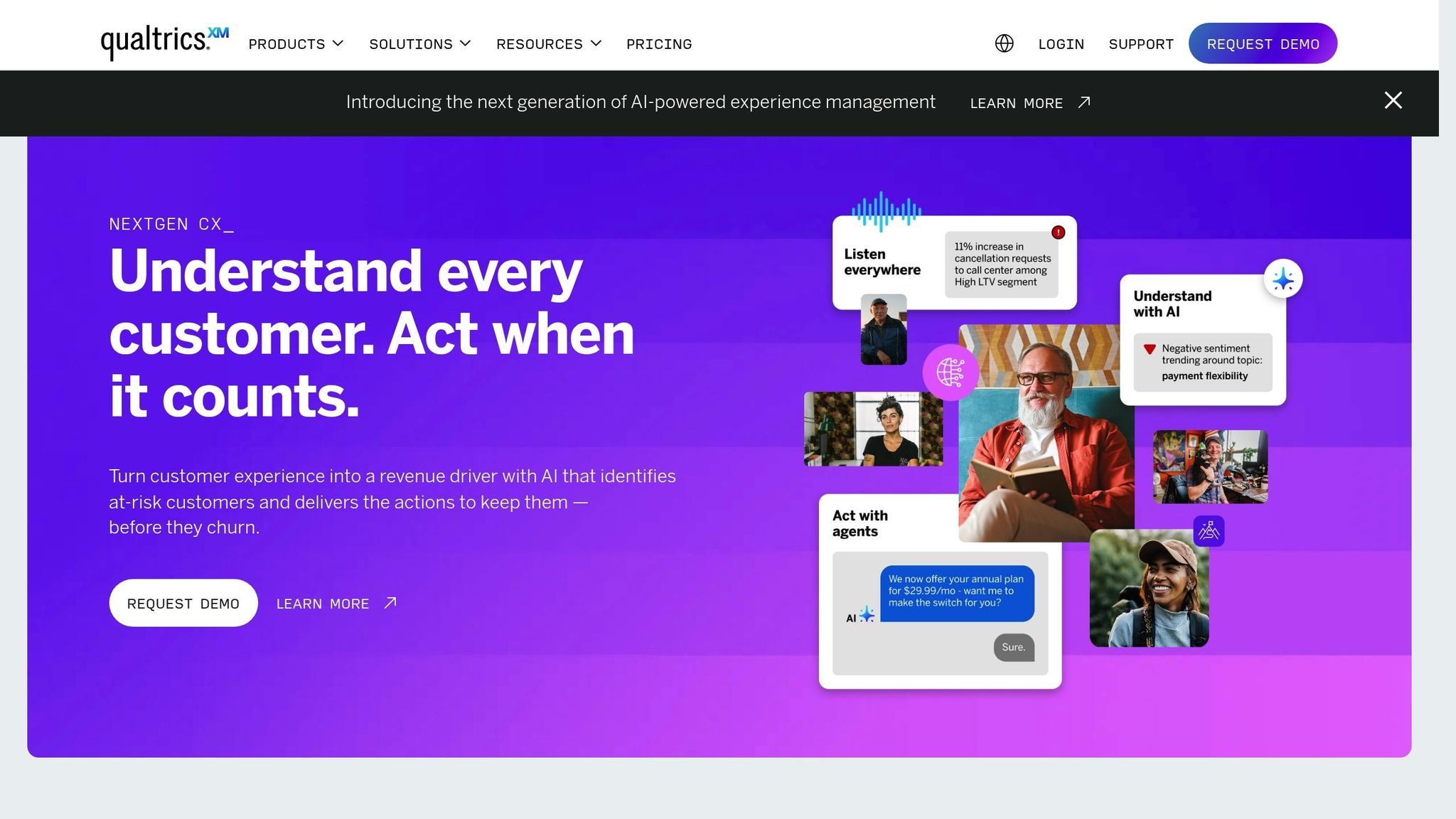
Qualtrics takes AI call quality monitoring to the next level by turning raw conversational data into actionable insights, empowering businesses to improve their services in real time.
Real-time Analytics
With its real-time analytics, Qualtrics helps businesses monitor brand health, keep an eye on competitors, and understand changing consumer sentiment. The XM for Strategy & Research suite provides instant audio and video feedback, allowing teams to address issues as they arise. This capability ensures call centers can quickly spot and resolve quality problems or customer satisfaction concerns, enabling immediate action when it matters most.
Predictive Modeling
Qualtrics uses AI to move businesses from reactive problem-solving to proactive management. By identifying potential service issues before they escalate, companies can prevent disruptions and maintain high-quality service. This proactive approach not only resolves problems but also helps businesses stay ahead of challenges as they grow.
Scalability
As service demands increase, Qualtrics adapts effortlessly to meet them. Its AI-driven platform supports unlimited users across its Customer Experience, Employee Experience, and Strategy & Research suites, processing millions of data points for rapidly expanding businesses. Sara Condiff, Head of Employee Experience at Navistar, shared:
"We needed a solution that would let us analyze open text feedback scale, process it, and understand what was driving sentiment. Once we did this we were able to give our leaders very clear insights on what was most important to our people and where to focus our actions for positive outcomes."
Beyond scalability, Qualtrics offers tools for continuous brand tracking and advanced research, helping businesses accelerate growth and adapt to the evolving demands of customer service operations.
sbb-itb-abfc69c
5. Loris
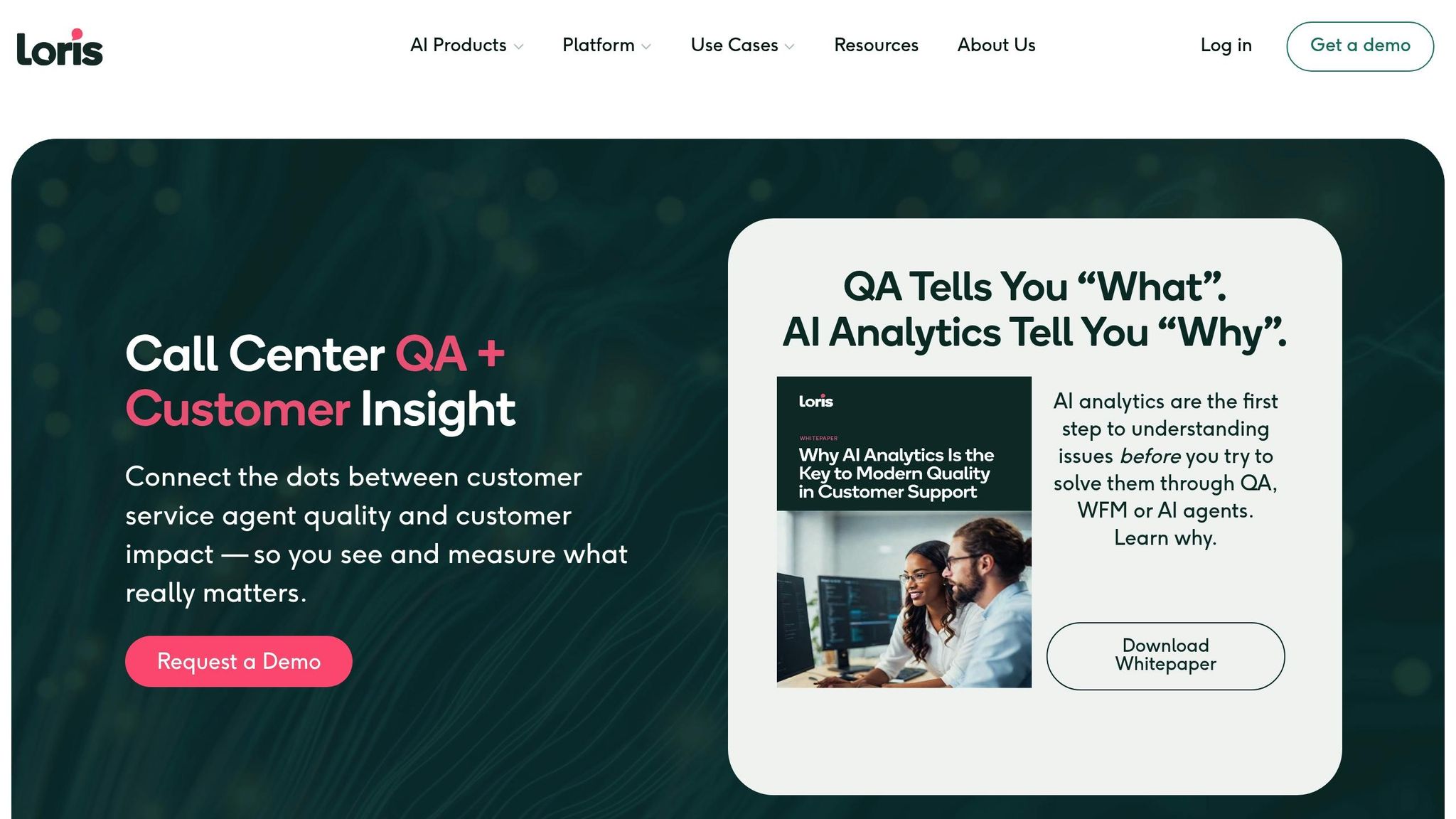
Loris uses cutting-edge predictive analytics to enhance call quality by providing real-time insights and monitoring performance proactively. The platform turns customer conversations into actionable data, helping businesses spot patterns and predict outcomes before they disrupt customer satisfaction.
Real-time Analytics
Loris analyzes customer interactions as they happen, offering instant insights into call quality and agent performance. With its real-time monitoring tools, the platform tracks conversation flow, customer sentiment, and compliance across all communication channels. If critical issues arise - like escalating frustration or possible compliance breaches - Loris immediately notifies supervisors, enabling quick action through coaching or call transfer.
Its sentiment analysis engine evaluates emotional cues in real time, generating live performance scores and satisfaction predictions. This continuous feedback loop empowers managers to make on-the-spot adjustments, improving call outcomes while the conversation is still underway.
Predictive Modeling
Beyond real-time monitoring, Loris employs machine learning to predict customer behavior and business outcomes. By analyzing historical conversation data, it can estimate churn risk, pinpoint upselling opportunities, and foresee potential service escalations. These insights allow businesses to address problems before they escalate, protecting customer relationships.
Loris also forecasts agent performance trends, helping managers identify team members who may need extra training or support. This forward-thinking approach ensures that quality remains consistent while optimizing how resources are used across the call center.
6. Answering Agent
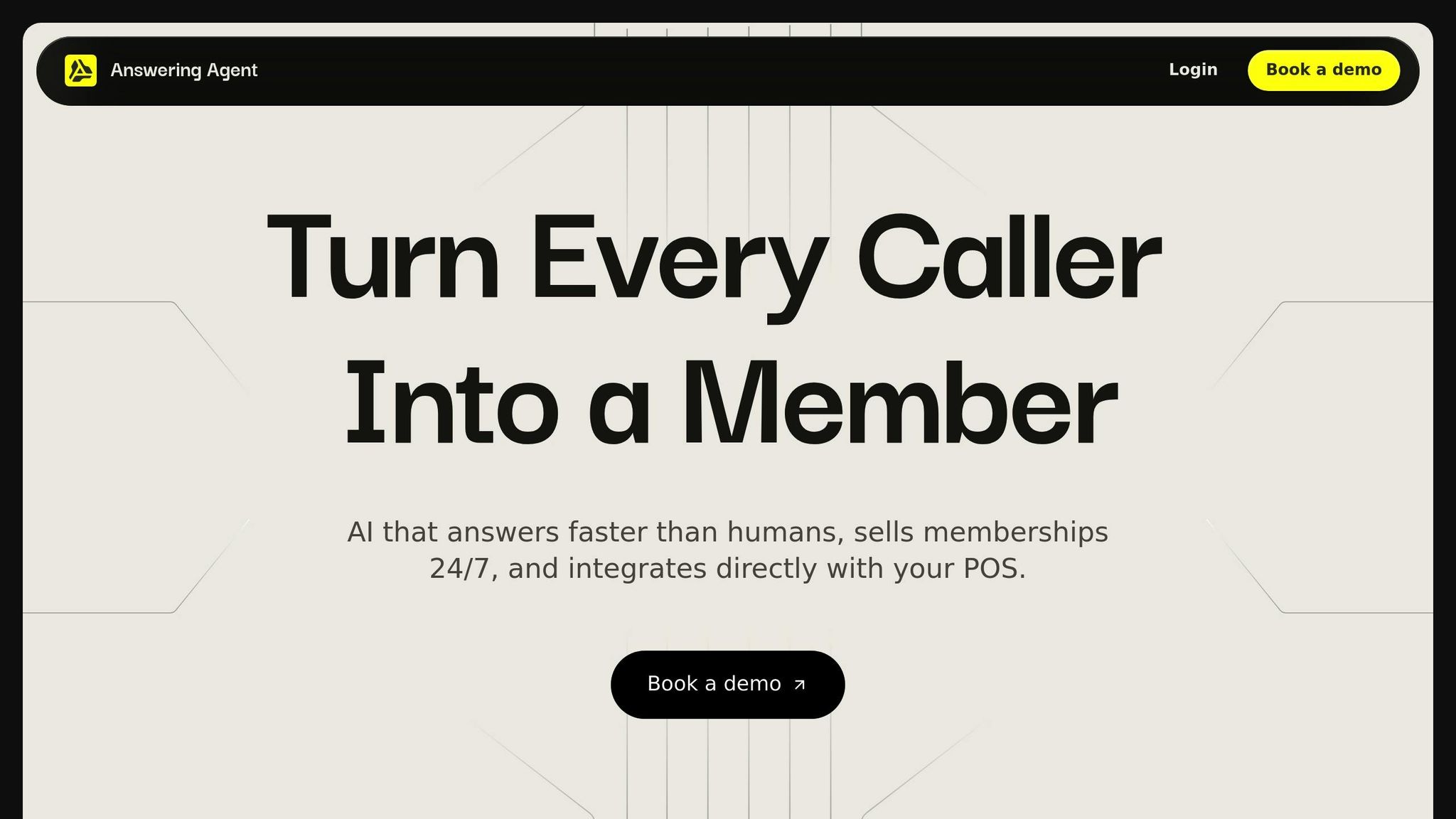
When it comes to advanced tools for predictive analytics, Answering Agent stands out by blending AI-driven call management with customer service automation. It offers AI-powered phone answering services designed to enhance both call handling and customer interactions. With round-the-clock availability and a user-friendly call management dashboard, it ensures continuous call monitoring and efficient customer interaction management.
Real-time Analytics
The platform’s dashboard provides live insights into call performance, using AI to identify potential call quality issues before they escalate. This allows for real-time monitoring, smooth appointment scheduling, and timely follow-ups with customers. These features ensure conversations stay professional and natural, creating a better overall experience for customers.
Scalability
Thanks to its cloud-based infrastructure, Answering Agent can handle an unlimited number of calls at the same time. The system adjusts automatically to accommodate increasing call volumes, ensuring consistent call quality no matter how much demand grows.
Tool Comparison: Benefits and Drawbacks
Predictive analytics tools come with their own set of strengths, challenges, and pricing structures. Knowing these trade-offs is key for organizations aiming to make choices that align with their goals and budget.
Level AI stands out for its advanced natural language processing (NLP) capabilities, particularly in identifying emotional patterns and sentiment across high call volumes. However, it requires a high level of technical expertise for setup and often comes with a steep price tag, with enterprise plans typically exceeding $10,000 per month - making it less suitable for smaller businesses.
Observe AI shines in compliance monitoring, automatically flagging potential violations and maintaining detailed records. While these features are invaluable for regulated industries, smaller businesses may face limited customization options, and the platform's learning curve can extend the time needed for implementation.
CallMiner is known for its specialized speech analytics, offering industry-specific models and delivering quick call processing with detailed performance metrics. However, its complex integration requirements and the higher costs for advanced features might be barriers for mid-sized companies.
Qualtrics combines survey data with call analytics through a unified dashboard, enabling businesses to link customer feedback with call performance. That said, its call analytics features aren't as robust as those of tools dedicated solely to call monitoring, and costs can rise significantly with additional features.
Loris appeals to small and medium-sized businesses with its user-friendly interface and simple setup process. Its affordable entry-level pricing is a major draw, but it lacks the scalability and advanced analytics needed for larger enterprises.
Answering Agent offers an affordable solution for AI-powered call management, capable of handling unlimited simultaneous calls. Industry data suggests that AI-powered contact centers can lower operational costs by up to 30% while boosting customer satisfaction by 15–20%. Its strengths include 24/7 availability and natural, conversational AI, making it an efficient choice for businesses without the complexity of traditional enterprise systems.
To simplify the comparison, here’s a quick overview of each tool's features, limitations, target users, and pricing:
| Tool | Key Strengths | Main Limitations | Best For | Typical Cost Range |
|---|---|---|---|---|
| Level AI | Advanced NLP, emotion detection | High cost, technical setup | Large enterprises | $10,000+ monthly |
| Observe AI | Compliance monitoring, audit trails | Limited customization | Regulated industries | $5,000–15,000 monthly |
| CallMiner | Industry-specific models, fast processing | Complex integration | Mid to large businesses | $3,000–12,000 monthly |
| Qualtrics | Survey integration, unified dashboard | Limited call analytics | Customer experience teams | $2,000–8,000 monthly |
| Loris | User-friendly, quick deployment | Limited scalability | Small to medium businesses | $500–3,000 monthly |
| Answering Agent | Cost-effective, unlimited calls | Newer platform | Service businesses | $100–2,000 monthly |
When choosing a predictive analytics tool, cost is often a deciding factor. Tools like Answering Agent and Loris, priced between $100 and $2,000 monthly, are more accessible for smaller businesses. On the other hand, enterprise solutions like Level AI and CallMiner demand a larger investment but offer capabilities suited for large-scale operations.
Integration and implementation timelines also vary. While some tools feature quick deployment, more comprehensive systems may require extended rollout periods. As highlighted, factors like scalability and integration complexity can significantly impact overall costs.
It’s also important to consider hidden expenses - such as training, maintenance, and upgrades - which can match or even exceed subscription fees. Factoring in these costs ensures a clearer picture of the total investment required for each tool. By weighing these aspects carefully, businesses can select a solution tailored to their specific needs and objectives.
Conclusion
Predictive analytics tools are transforming how businesses monitor and improve call quality, offering scalable solutions that fit companies of all sizes. These advancements highlight the growing influence of AI analytics in shaping customer interactions.
Our analysis reveals a clear distinction between enterprise-grade platforms and tools tailored for smaller businesses. Larger organizations often gravitate toward comprehensive platforms that provide features like automated compliance monitoring and sentiment analysis. These capabilities have a proven impact on enhancing service quality. Meanwhile, small and medium-sized businesses benefit from accessible and budget-friendly tools, such as Loris and Answering Agent, which deliver key predictive analytics functions without unnecessary complexity. With 88% of customers likely to return after a great service experience, even smaller businesses can see meaningful improvements by adopting these tools.
Predictive analytics is becoming a cornerstone of proactive call quality management. With 71% of customers switching communication channels depending on their situation, businesses need tools that can adapt and anticipate customer needs across various touchpoints. These tools enable companies to detect potential issues early, provide real-time guidance to agents, and ensure consistent service quality - critical elements for staying competitive.
These solutions not only address today’s challenges but also pave the way for future advancements in call quality monitoring. When choosing a tool, businesses should weigh factors like cost, ease of integration, and scalability to align with their specific goals.
As AI technology evolves, predictive analytics tools will become even better at identifying trends, forecasting customer behavior, and improving call outcomes. Businesses that embrace these capabilities now are positioning themselves to deliver exceptional customer experiences, cut operational costs, and thrive in an increasingly competitive market.
FAQs
How do AI tools monitor call quality and predict customer behavior to improve interactions?
AI-driven call quality monitoring tools use advanced algorithms to analyze recorded conversations, call patterns, and customer feedback. These tools can spot trends and anticipate customer needs, helping businesses create more tailored and proactive interactions.
They also offer real-time insights that improve agent performance, pinpoint areas for coaching, and streamline query resolution. This not only enhances the customer experience but also increases efficiency and satisfaction across the board.
What should businesses look for in an AI call quality monitoring tool, especially regarding cost and scalability?
When choosing an AI call quality monitoring tool, businesses should focus on two main aspects: affordability and scalability.
On the cost side, consider factors like setup fees, subscription charges, and how much the tool can save your business through automation. For instance, automation can cut down on labor costs and streamline operations, leading to better overall efficiency.
Scalability is equally important. The tool should be capable of handling growing call volumes without sacrificing performance. Features like quick response times, the ability to smoothly manage heavy call traffic, and adaptability to your business’s future needs are critical. The best tools strike a balance between being budget-friendly and offering the flexibility to expand, ensuring they can support your business as it grows.
How does predictive analytics enhance call quality monitoring to boost customer satisfaction and efficiency?
Predictive analytics takes call quality monitoring to the next level by spotting potential problems early, allowing businesses to resolve them before they affect customer experiences. This forward-thinking approach creates smoother, more tailored interactions, boosting customer satisfaction.
On top of that, it enhances operational efficiency by fine-tuning resource allocation, cutting down call handling times, and offering real-time, actionable insights. These advantages not only help reduce costs but also simplify workflows and ensure consistently excellent service.
Related Blog Posts
Related Articles
How Decentralized Call Management Impacts Multi-Location Businesses
Explore how decentralized call management enhances service efficiency, customer satisfaction, and operational resilience for multi-location businesses.
How To Measure Retention ROI With AI Services
Learn how to effectively measure the ROI of customer retention strategies using AI services, focusing on key metrics and financial impacts.
Why Google Calendar and Outlook Sync Matters for Businesses
Syncing Google Calendar with Outlook enhances productivity, prevents scheduling conflicts, and improves customer experience for businesses.
